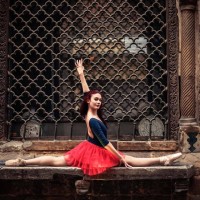In a country like Egypt, though ballet is always considered a symbol of beauty, luxury, and smoothness, seeing a ballerina dancing in the crowded streets can be a cultural shock for many. Mohammed Taher, a photographer, producer, and director, decided to introduce ballet in the streets to the public, with the aim of shedding light on the architecture of some historical places that reflect our Egyptian heritage. His project “Ballerinas of Cairo” managed to capture the contrast in a conservative society that appreciates beauty and art.
“The whole project was inspired by a similar project in New York called ‘The Ballerina Project’, which encouraged ballerinas to perform in the streets instead of on a stage,” Taher said.
“Thus, we wanted to launch this project in Cairo to capture some photos that portray how the smoothness of ballet as an art can meet the roughness of the city in an outstanding scene,” he added.
Six photographers volunteered to join the project, with the aim of providing new perspectives to the issue. They include Ahmed Fathy, Amir El Shenawy, Aya Ahmed, and others. Each photographer has the freedom to choose the places they prefer to portray in their shots. Most of the photos were taken in old places like Al-Qalaa, Korba, Al Moez Street, Downtown, Al-Hussein, and others. The latest photo shoot was taken in Aswan.
“Contacting the ballerinas wasn’t an easy task when we started, but now many of them volunteer to participate in the photo sessions we produce. Although most of them were enthusiastic about the idea at the beginning, they were so worried about the way in which people will treat them, regard them, and the extent to which they will accept their artistic style,” he noted.
However, the feedback of the people was surprising for the groups, who expected different kinds of harassment and bullying.
“People usually ask the ballerina’s permission to take photos with them, and they usually give us very encouraging feedback to move forward. I really want to thank our outstanding ballerinas Nervana El Nahal, Roshan Hesham, Veronica Emad, Mariam El Gebaly, and Nour El Gazar, who overcame a lot of challenges because they believe in the importance of the project,” he added.
To integrate people more into the experience, Taher intends to post some videos for the making of the photo sessions on social media to help people understand how the process normally goes.
“We also plan to hold an exhibition to display the best photos we took. A collection of unpublished photos will also be presented to encourage more people to come and have a look at our project,” he concluded.












